การพัฒนาหลักสูตรบูรณาการกลุ่มสาระการเรียนรู้ศิลปะ เรื่อง การอนุรักษ์ศิลปะและวัฒนธรรมท้องถิ่นจังหวัดสมุทรปราการ สำหรับนักเรียนชั้นประถมศึกษาปีที่ 4 (THE DEVELOPMENT OF INTEGRATED CURRICULUM IN ART SUBJECT GROUP ON THE CONSERVATION OF LOCAL ART AND...)
Keywords:
หลักสูตรบูรณาการ, กลุ่มสาระการเรียนรู้ศิลปะ, การอนุรักษ์ศิลปะและวัฒนธรรมท้องถิ่นจังหวัดสมุทรปราการ, Integrated curriculum, Art subject, The conservation of local art and culture in Samutprakan provinceAbstract
บทคัดย่อ
การวิจัยครั้งนี้ เป็นการวิจัยและพัฒนา มีจุดประสงค์ เพื่อ 1) พัฒนาหลักสูตรบูรณาการ กลุ่มสาระการเรียนรู้ศิลปะ เรื่อง การอนุรักษ์ศิลปะและวัฒนธรรมท้องถิ่นจังหวัดสมุทรปราการ 2) เพื่อเปรียบเทียบผลสัมฤทธิ์ทางการเรียนของนักเรียนที่ได้รับการสอนด้วยหลักสูตรบูรณาการ 3) เพื่อศึกษาผลของการฝึกทักษะการปฏิบัติงานของนักเรียน 4) เพื่อศึกษาเจตคติของนักเรียนที่มีต่อการเรียน กลุ่มตัวอย่างที่ใช้ในการวิจัยได้แก่ นักเรียนชั้นประถมศึกษาปีที่ 4 โรงเรียนคลองบางปิ้ง สังกัดสำนักงานเขตพื้นที่การศึกษาประถมศึกษาสมุทรปราการ เขต 2 ปีการศึกษา 2553 จำนวน 34 คน ได้มาโดยการเลือกแบบเจาะจง (Purposive Sampling) โดยมีการดำเนินการ 4 ขั้นตอน คือ 1) กระบวนการพัฒนาหลักสูตร 2) การหาคุณภาพหลักสูตร 3) การทดลองใช้หลักสูตร และ 4) การประเมินผลและการปรับปรุงหลักสูตร เครื่องมือที่ใช้ในการทดลองได้แก่ หลักสูตรบูรณาการกลุ่มสาระการเรียนรู้ศิลปะแบบวัดผลสัมฤทธิ์ทางการเรียน แบบประเมินทักษะ การปฏิบัติงานและแบบประเมินเจตคติของนักเรียนที่มีต่อการเรียน ซึ่งผ่านการประเมินจากผู้เชี่ยวชาญว่ามีคุณภาพ สามารถนำไปใช้ได้ สถิติที่ใช้ในการวิเคราะห์ข้อมูล ได้แก่ ค่าเฉลี่ย (X) ค่าเบี่ยงเบนมาตรฐาน (SD) และการทดสอบค่าที (t-test)ผลการวิจัยสรุปได้ดังนี้
ขั้นตอนที่ 1 กระบวนการพัฒนาหลักสูตร มีการดำเนินการดังนี้
ส่วนที่ 1 การศึกษาข้อมูลพื้นฐาน
1. สำรวจความต้องการของครูผู้สอนกลุ่มสาระการเรียนรู้ศิลปะ ในการพัฒนาหลักสูตรบูรณาการกลุ่มสาระการเรียนรู้ศิลปะ เรื่อง การอนุรักษ์ศิลปะและวัฒนธรรมท้องถิ่นจังหวัดสมุทรปราการ ของโรงเรียนในสังกัดสำนักงานเขตพื้นที่การศึกษาประถมศึกษา สมุทรปราการ จำนวน 158 โรงเรียน ได้ผลสรุป เพื่อนำมากำหนดปรัชญา แนวคิดและจุดเน้นของหลักสูตร
2. ศึกษาความคิดเห็นของการพัฒนาหลักสูตรบูรณาการ กลุ่มสาระการเรียนรู้ศิลปะของนักเรียน ชั้นประถมศึกษาปีที่ 4 และครูผู้สอนกลุ่มสาระการเรียนรู้ศิลปะทั้ง 3 สาระคือ ทัศนศิลป์ ดนตรี และนาฏศิลป์ และความต้องการด้านเนื้อหา โดยใช้เทคนิคการสัมภาษณ์เชิงลึก (In-depth Interview) เพื่อนำมากำหนด เป้าหมาย ความมุ่งหมาย จุดประสงค์ เนื้อหาของหลักสูตรและจัดทำหลักสูตรให้สมบูรณ์
3. ศึกษาเอกสารตำราและงานวิจัยที่เกี่ยวข้องกับการพัฒนาหลักสูตรบูรณาการ กลุ่มสาระการเรียนรู้ศิลปะเรื่อง การอนุรักษ์ศิลปะและวัฒนธรรมท้องถิ่นจังหวัดสมุทรปราการ เพื่อศึกษาองค์ประกอบของหลักสูตร ได้ผลสรุปขององค์ประกอบของหลักสูตรดังนี้ คือ ปรัชญา แนวคิด และจุดเน้นของหลักสูตร เป้าหมายของหลักสูตร ความมุ่งหมายและจุดประสงค์หลักสูตร เนื้อหา หน่วยการเรียนรู้และอัตราเวลาเรียน ข้อเสนอแนะเกี่ยวกับการสอน บทบาทครู บทบาทนักเรียน สื่อ อุปกรณ์ แหล่งเรียนรู้ การวัดและประเมินผล และแนวทางการจัดกิจกรรมการเรียนการสอน
ส่วนที่ 2 การออกแบบหรือการยกร่างหลักสูตร
เป็นการสร้างหลักสูตรให้สอดคล้องกับผลการศึกษาข้อมูลพื้นฐาน เมื่อได้ข้อมูลพื้นฐานมาแล้วจึงนำมาออกแบบหรือยกร่างหลักสูตร ประกอบด้วย ปรัชญา แนวคิดและจุดเน้นของหลักสูตร เป้าหมายของหลักสูตร ความมุ่งหมายและจุดประสงค์หลักสูตร เนื้อหา หน่วยการเรียนรู้และอัตราเวลาเรียน ข้อเสนอแนะเกี่ยวกับการสอน บทบาทครู บทบาทนักเรียน สื่อ อุปกรณ์ แหล่งเรียนรู้ การวัด และประเมินผล และแนวทางการจัดกิจกรรมการเรียนการสอน
ขั้นตอนที่ 2 การหาคุณภาพของหลักสูตร เป็นการตรวจสอบคุณภาพของหลักสูตรก่อนนำไปทดลองใช้ โดยผู้เชี่ยวชาญ จำนวน 5 คน พิจารณาประเมินความเหมาะสมและความสอดคล้อง พบว่า ทุกองค์ประกอบของหลักสูตรมีความเหมาะสมและความสอดคล้องกัน
ขั้นตอนที่ 3 การทดลองใช้หลักสูตร เป็นการนำหลักสูตรมาใช้กับกลุ่มตัวอย่าง แบ่งออกเป็น 2 ส่วน คือ
ส่วนที่ 1 การศึกษานำร่อง (Pilot Study) โดยนำไปทดลองใช้กับนักเรียนโรงเรียนพร้านิลวัชระ ซึ่งเป็นโรงเรียนนำร่องการใช้หลักสูตรแกนกลางการศึกษาขั้นพื้นฐาน พุทธศักราช 2551 จำนวน 30 คน เพื่อศึกษาความเป็นไปได้ของการใช้หลักสูตรในสถานการณ์จริง
ส่วนที่ 2 การทดลองใช้หลักสูตร นำไปทดลองใช้กับกลุ่มตัวอย่างซึ่งเป็นนักเรียนโรงเรียน คลองบางปิ้ง สังกัดสำนักงานเขตพื้นที่การศึกษาประถมศึกษาสมุทรปราการเขต 1 ภาคเรียนที่ 1 ปี การศึกษา 2553 จำนวน 34 คน ใช้เวลาการทดลอง 40 ชั่วโมง การทดลองครั้งนี้ใช้แบบแผนการทดลองแบบ One – Group Pretest – Posttest Design วิเคราะห์ข้อมูลโดยการทดสอบค่า t (t-test for dependent samples) พบว่า นักเรียนมีผลสัมฤทธิ์ทางการเรียนหลังเรียนสูงกว่าก่อนเรียนอย่างมีนัยสำคัญทางสถิติที่ระดับ .05 นักเรียนมีความสามารถทางด้านทักษะการปฏิบัติงาน ภาพรวมอยู่ในระดับดีมาก มีค่าเฉลี่ย 3.83 ค่าเบี่ยงเบนมาตรฐาน 0.68 และนักเรียนมีเจตคติต่อการเรียนด้วยหลักสูตรบูรณาการกลุ่มสาระการเรียนรู้ศิลปะอยู่ในระดับมากที่สุด มีค่าเฉลี่ย 4.65 ค่าเบี่ยงเบนมาตรฐาน 0.48
ขั้นตอนที่ 4 การประเมินผลและการปรับปรุงหลักสูตร เป็นการประเมินผลหลังจากการทดลองใช้หลักสูตร พบว่า หลักสูตรที่พัฒนาขึ้นมีประสิทธิภาพและผู้วิจัยได้ดำเนินการปรับปรุงเพื่อให้ได้หลักสูตรที่สมบูรณ์ นำไปเผยแพร่ต่อไป
ABSTRACT
The purposes of this research and development were: 1) to develop the integrated curriculum in an Art Subject Group at the Conservation of Local Art and Culture in Samutprakan Province 2) to compare the achievements of students who were taught with the integrated curriculum, 3) to study the effectiveness of practice training 4) to study the attitudes of students.
The samples were thirty-four students in Pathomsuksa IV, at Khlong Bang Ping School, under Samutprakan Primary Educational Service Area Office 1, in the academic year 2010. The samples were selected by purposive sampling. There were 4 steps used for the curriculum development procedure as follows: 1) the process of curriculum development 2) to discover the quality of curriculum 3) curriculum implementation and 4) curriculum evaluation and revision. Experiment equipment was the integrated curriculum in Art subject group, achievement, skill test as well as student’s attitude test which had been approved by experts. The statistics used for analyzing the data were mean, standard deviation, and t-test respectively.
The research finding was summarized as follows:
Step I : Curriculum development process.
Section 1: Basic information study.
1. To survey the need assessments of Art teachers toward development of the integrated curriculum in the Art Subject Group. The samples for study were 158 schools in the Samutprakan Primary Educational Service Area office 1. The test conclusions were utilized for setting Philosophy, conceptual frame and curriculum emphasis.
2. To study the opinions of Pathomsuksa IV students and Art teachers toward the integrated curriculum in the Art Subject Group. The three strands of learning the art were visual arts, music & dance, and content requirements. Data was collected by using in-depth interview techniques in order to identify the goals, the specific objectives and content in curriculum.
3. To review documents and related literature for the development of Integrated Curriculum in Art Subject Group. The elements of the curriculum focused on curriculum, philosophical concepts objectives of the course curriculum, curriculum unit, learning time structure, suggestions about the role of teachers, the role of the students, the learning media, the learning assessment, and the management of learning respectively.
Part 2 Design or drafting curriculum.
The curriculum was in line with the results of basic information and was based on the data and then used to design or draft the courses included philosophy, concepts, and the focus of the curriculum objectives of the course. The aims and objectives of curriculum units, learning time structure, suggestions about the role of teachers, the role of the students, learning media, learning assessment, and learning management were implemented.
Step II : Quality of the drafted curriculum. The expert assessment by 5 people focused on appropriateness and congruence.
Step III : The curriculum implementation. The first pilot study was tried out at Phanilwatchara
School as pilot school for basic education core curriculum B.E. 2551, and thirty students were the purposive sample. The objective was to study the feasibility in the real situation. Section 2 trial program was to use the sample school, Klongbangping School under the Samutprakan Primary Educational Service Area Office 1. Thirty-four students used the test plan for 40 hours in first semester of 2553 academic year. One - Group Pretest - Posttest Design was analyzed by t-test (paired). The study found academic achievement was higher at .05 significance and student performance skills were very good at a level X 3.83, SD .68, the student’s attitudes were very high level X 4.65, and SD .48.
Step IV : Assessment and revision. Final evaluation, the program was developed and found to be very effective. Researchers approved the curriculum for general distribution and use.


